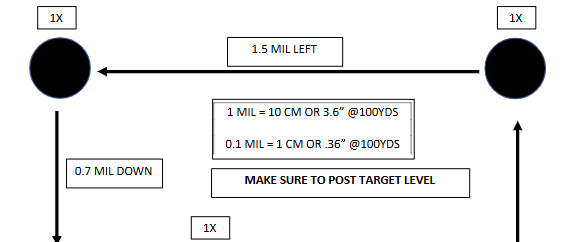Zero Tracking the What and How
One of the most important metrics for a scope’s reliability is its ability to “track” accurately. Zero tracking refers to the scope’s mechanical integrity, ensuring that when you adjust the elevation or windage turrets, the internal reticle moves precisely and consistently. For long-range shooters, who rely on dialing in exact adjustments for every shot, a scope that doesn’t track properly is a liability.
The Importance of Reliable Tracking
Imagine you’ve used a ballistic calculator to determine you need to dial your scope up by 9.9 MIL to hit a target at 800 yards. If your scope’s tracking is off, that 9.9 MIL adjustment might only move the point of impact by 9.5 MIL or, worse, 10.4 MIL. This seemingly small error can translate to over 17 inches, in perfect conditions. A scope tracking drill is the only surefire way to verify that your optic’s internal mechanisms are working and are of a high enough quality to be employed by a sniper. It’s also a fundamental test that builds confidence and ensures your equipment is up to the task.
The Scope Tracking Drill
The best scope tracking drill we’ve found is the one developed by our brothers over at LA Snipers. (Click here to get a copy.)
- Shoot from 100 yards. This is the distance that most people zero their rifles. It’s easier to see the target and less outside effects on the projectile while in flight.
- Place target perfectly level. Use a bubble level to make sure the page is level to the ground. This is critical to ensure theirs nothing off with your scope.
- Use a single aiming point. This is the hardest concept for most people to understand. Your aiming point will remain the same, the impact points will change.
- Simple Tracking Drill (Print sheet above.) Choose a spot and shoot once. Shot 2 move your windage 1 Mil right, Shot 3 move elevation 1.5 Mil up, Shot 4 move windage 1.5 Mil left, Shot 5 move elevation .7 Mil down, Shot 6 move windage .5 Mil right, Shot 7 move elevation .8 Mil down. This should return you to your original aiming point.
If you wanted to measure, Shot 1 is your starting point. Shot two should be 10cm right of your first shot. Shot three should be be 15cm up the second. Shot four should be 15cm left of the third shot. Shot five should be 7cm down from the fourth shot. Shot six should be 5cm right of the fifth shot. Shot seven should be 8cm down from the sixth shot, and should be in the exact same spot as shot 1.


Why It Matters
Passing this drill is a testament to a scope’s exceptional mechanical quality. For a police sniper, this reliability and quality can be the difference between a successful resolution and a tragic outcome. It provides the confidence to make quick, critical turret adjustments for shots at varying distances, ensuring the highest degree of precision. A rifle system is only as strong as its weakest component, and a scope that fails to track is a significant liability. By consistently performing this tracking drill, you’re not just validating your gear; you’re cultivating the deep trust essential for making critical, high-stakes shots with unwavering confidence.

